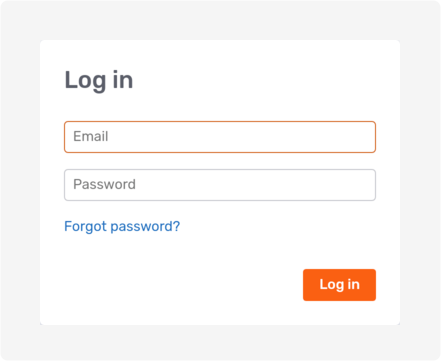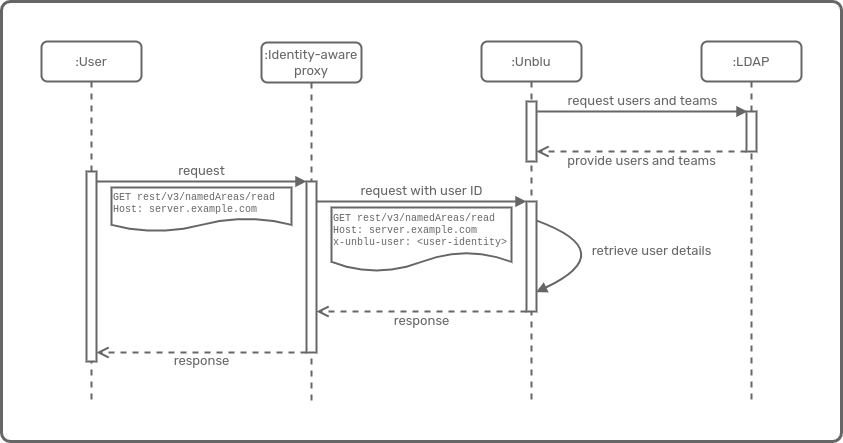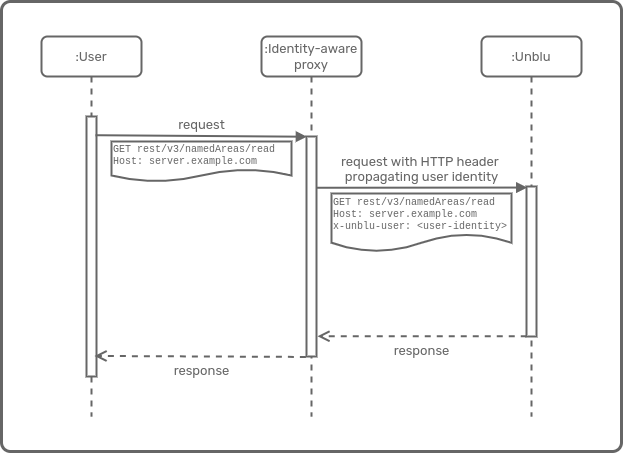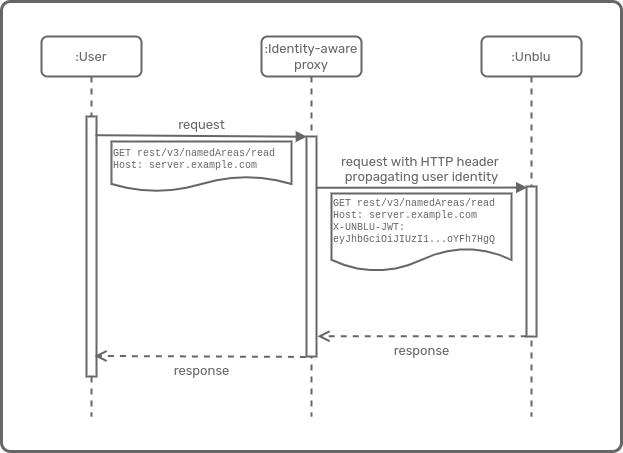|
This document describes version 6 of Unblu. If you’re using the latest major version of Unblu, go to the documentation of the latest version. The support period for version 6 ended on 29 August 2023. We no longer provide support or updates for this version. You should upgrade to the latest version of Unblu. |
Authentication in self-hosted and on-premises installations
| This article discusses the authentication methods available in self-hosted and on-premises installations. For information on authentication in the Unblu Financial Cloud (UFC), see Single sign-on in the Unblu Financial Cloud in the latest documentation. |
The collaboration server supports several different approaches to authentication.
Authentication is configured based on the request’s call origin, which in turn is determined by the access path prefix of the request URL. The path prefixes for trusted and untrusted call origins, which are relevant for authentication, are specified in the following configuration properties:
-
com.unblu.identifier.restrictedPathPrefix for the trusted call origin.
-
com.unblu.identifier.publicPathPrefix for the untrusted call origin
The default values are /co-unblu for trusted call origins and /unblu for untrusted call origins. If the trusted and untrusted access path prefixes are identical, only the authentication configuration for the trusted call origin is used.
When configuring authentication for Unblu, the first decision to make is which authentication sources should be used for each call origin.
-
Add trusted sources to com.unblu.authentication.trusted.sources.
-
Add untrusted sources to com.unblu.authentication.untrusted.sources.
For a given call origin, you can configure multiple sources.
Authentication source NONE
The NONE source only makes sense for the untrusted call origin. It means that unauthenticated visitors are allowed to use Unblu.
For the trusted call origin, the NONE source is only accepted when the trusted and untrusted entry path are the same. If they differ the value is rejected, because the concept of an unauthenticated agent makes no sense.
Using NONE with other authentication sources such as PROPAGATED and or LOCAL allows unauthenticated visitors to become authenticated while they are using Unblu. This concept is called "user change" and is explained in the section Unauthenticated access & authentication change tracking.
Authentication source LOCAL
With the LOCAL source, authentication is carried out using the built-in user management system which allows you to manage users in the agent desk or using the Web API.
When logging in from an untrusted call origin, users can only attain the WEBUSER role. Login may only be performed with the Web API (see below).
From a trusted call origin, only users with at least the REGISTERED_USER role may log in. They may do so using the login form (to obtain access to the agent desk) or the Web API.
Users must have a password to be able to log in.
Agent Desk login form
Agents can log in to the Unblu agent desk using a traditional form requiring a username and password.

Web API basic authentication
When using the Web API, the "basic authentication" mechanism can be used by setting the following configuration properties to true as required:
If you opt for this authentication method, the Authorization HTTP header must be sent with each request.
Web API authenticator service
The Web API’s authenticator service provides several alternatives to basic authentication.
A successful login will result in a response that includes a Set-Cookie HTTP header, irrespective of the endpoint used for authentication. The client can cache the provided cookie and include it with subsequent requests. This is the default behavior in web browsers, but may require additional configuration for other HTTP clients.
With username and password
The endpoint authenticator/login allows a login with a username and password.
With a token
The endpoint authenticator/authenticateWithToken is similar to authenticator/login, but is available as a GET request. Instead of username and password sent as JSON request body, it expects the single query parameter authenticationToken.
The token can be created with the endpoints:
-
authenticator/createAuthenticationToken(using ausernameandpassword) -
authenticator/createAuthenticationTokenForCurrentUser
It is only valid for a brief period (configured with com.unblu.authenticator.authenticationTokenTTLInSeconds).
| Since this HTTP request is a GET request, systems that keep track of requested URLs may store this authentication token. |
With a JSON web token (JWT)
The endpoint authenticator/loginWithSecureToken allows for logging in using a JSON Web Token (JWT). It’s only available to authenticated users with the WEBUSER role on the untrusted entry path.
To use this authentication method, the configuration property com.unblu.authentication.tokenSignup.enabled must be true.
The method provides several JWT claims to propagate visitor information to the Unblu server. The configuration properties to map these claims to visitor properties can be found in the group com.unblu.platform.server.core.auth.configuration.ClaimMappingConfiguration.
The values of JWT claim mappings are case sensitive: "john.smith@yourcompany.com" and "John.Smith@yourcompany.com" aren’t the same value.
The example below demonstrates how to map JWT claims to visitor properties.
com.unblu.authentication.tokenSignup.claimMapping.username=email
com.unblu.authentication.tokenSignup.claimMapping.email=email
com.unblu.authentication.tokenSignup.claimMapping.firstName=firstName
com.unblu.authentication.tokenSignup.claimMapping.lastName=lastName
com.unblu.authentication.tokenSignup.claimMapping.additionalInformation=otherUsers authenticated with a JWT will be created on the fly as virtual users (see User modes below).
A sample app demonstrating this authentication method using a signed and encrypted JWT is available from the Unblu GitHub repository.
loginWithSecureToken is available in Unblu version 6.13.2 and later. |
Using the authenticator service to bypass the login form
The endpoint authenticator/loginWithToken provides the single query parameter redirectOnSuccess. This can be used to redirect the agent to a specific page in the Agent Desk upon successfully logging in.
The same approach can be used to open the Agent Desk in an iframe to integrate Unblu into another system:
-
First, the system obtains a valid authentication token with a backend call against the Web API.
-
It can then construct a URL such as the one as shown below and set the URL as the value of the
srcattribute of an<iframe>tag in the page it is serving.
https://unblu.cloud/unblu/rest/v3/authenticator/loginWithToken?authenticationToken=<token-value>&redirectOnSuccess=https%3A%2F%2Funblu.cloud%2Fco-unblu%2Fdesk%2F%23%2Finbox%2Fmy-conversations
Authentication source PROPAGATED
The collaboration server supports identity (ID) propagation as an alternative to the built-in user management system. ID propagation is available for agents from a trusted call origin as well as for visitors using an untrusted call origin.
ID propagation is configured separately for each call origin. A number of aspects of ID propagation need configuring:
-
The user mode (virtual or physical)
-
The definition of the propagated values
-
The source of the propagated values
Propagated users do not differ greatly from regular, local users. The differences are:
-
In an ID propagation setup, it isn’t possible to log out from the Unblu system.
-
Users with the
SUPER_ADMINrole are not allowed to switch to other accounts or to impersonate other users. -
When users are created in the built-in user management system (see physical user mode below), they aren’t required to have a password.
User modes
It is possible to delegate agent authentication while still loading the users from the built-in user management system (i.e., in combination with automated user synchronization), or to use virtual users.

This is controlled with the configuration property com.unblu.authentication.propagated.trusted.virtualUserMode, which takes one of the following values:
-
DENY: The users have to be present in the Unblu user management system. This is referred to as physical user mode. -
ALWAYS: The users are never taken from Unblu’s user management system. This is called virtual user mode. -
ALLOW: both modes (physical and virtual) are possible.
In physical user mode, the users' details are retrieved from the Unblu database. The configuration property com.unblu.authentication.propagated.trusted.userId (not username) must be configured to enable Unblu to retrieve the value corresponding to the username property in the Unblu user management system. All other propagated values are ignored.
In virtual user mode, users are created in the database when they are first authenticated via ID propagation. Their property values are determined according to the configuration properties com.unblu.authentication.propagated.trusted.*. Any changes to these property values must be propagated; they cannot be edited in Unblu. You can, however, edit the settings and the canned responses of virtual users.
Prior to Unblu 6.28.2, virtual users weren’t created in the database. Instead, they were created on the fly, with their property values determined according to the configuration properties mentioned above.
In both physical and virtual user mode, a person entity will be created in order for the user to be present in conversations.
| The distinction between physical and virtual users doesn’t apply to visitors. Propagated visitor user identities are always virtual. |
Propagated values
The following user-related fields can be propagated.
Field |
Mandatory |
System entry paths |
username |
yes |
trusted, untrusted |
roles |
no |
trusted |
firstName |
no |
trusted, untrusted |
lastName |
no |
trusted, untrusted |
additionalInformation |
no |
trusted, untrusted |
authInfo |
no |
trusted, untrusted |
teamId |
no |
trusted |
accountId |
no |
trusted, untrusted |
Please take note of the following points:
-
If no account is specified, the server’s default account is used. When ID propagation is used with multiple accounts, the account must therefore be specified with each request.
-
For the
accountIdvalue, either the ID (e.g.wZvcAnbBSpOps9oteH-Oxw) or the name (e.g.Main Account) may be used. -
For the
teamIdvalue, too, either the ID or the team name may be used. -
Propagated roles are not case sensitive.
The following sources of propagation are supported:
name |
description |
format |
example configuration value |
header |
HTTP request header field |
header:<name> |
header:x-unblu-user-id |
attribute |
Java request attribute |
attribute:<name> |
attribute:x-unblu-user-id |
cookie |
HTTP cookie |
cookie:<name> |
cookie:x-unblu-user-id |
jee |
JEE-based authentication |
jee:principal |
jee:principal |
oidc |
OpenID Connect using opaque Access Tokens |
oidc:claim |
oidc:email |
jwt |
JSON Web Token |
jwt:claim |
jwt:email |
Examples
Below are a few examples of how to configure ID propagation for different sources.
Headers
In this first example, Unblu is configured to use the content of the HTTP request header field x-unblu-trusted-user-id as the agent’s user ID. Different headers are used for the visitor’s (untrusted) values.

# trusted path
com.unblu.authentication.trusted.sources=PROPAGATED (1)
com.unblu.authentication.propagated.trusted.userId=header\:x-unblu-trusted-user-id
com.unblu.authentication.propagated.trusted.virtualUserMode=DENY (2)
# untrusted path
com.unblu.authentication.untrusted.sources=PROPAGATED (1)
com.unblu.authentication.propagated.untrusted.userId=header\:x-unblu-untrusted-user-id
com.unblu.authentication.propagated.untrusted.firstName=header\:x-unblu-untrusted-first-name
com.unblu.authentication.propagated.untrusted.lastName=header\:x-unblu-untrusted-last-name| 1 | Only allow authentication through ID propagation (virtual user mode). To enable the Unblu login form as well as ID propagation, set the property to PROPAGATED,LOCAL. |
| 2 | Limit authentication to users already present in the Unblu user database. |
| When using identity propagation based on HTTP headers, the reverse proxy must be configured in such a way as to ensure that these headers can never be supplied from the outside. |
According to RFC 7230 only ASCII characters are allowed in header values. To support special characters nonetheless, Unblu requires that header values be encoded with URI percent encoding.
JSON web tokens
In this example, the user’s identity is supplied to Unblu using a JSON Web Token (JWT).

com.unblu.authentication.untrusted.sources=PROPAGATED
com.unblu.authentication.propagated.untrusted.userId=jwt\:email
com.unblu.authentication.jwt.httpHeader=X-UNBLU-JWT
com.unblu.authentication.jwt.jwkUrl=https\://www.googleapis.com/oauth2/v3/certs
com.unblu.authentication.jwt.expectedIssuer=https\://accounts.google.com| Support for JWT is available in Unblu version 6.6.0 and later. |
Opaque access tokens
OpenID Connect (OIDC) opaque Access Tokens can provide Unblu with user information in an Authorization: Bearer HTTP header. Unblu then calls the UserInfo endpoint to resolve the user information of the token.
com.unblu.authentication.oidc.userInfoEndpoint=https\://openidconnect.googleapis.com/v1/userinfo
com.unblu.authentication.untrusted.sources=PROPAGATED
com.unblu.authentication.propagated.untrusted.userId=oidc\:email
com.unblu.authentication.propagated.untrusted.firstName=oidc\:given_name
com.unblu.authentication.propagated.untrusted.lastName=oidc\:family_nameBy default, Unblu caches the Access Tokens for an hour. If your application uses tokens that are valid for less than an hour, you should adjust your configuration along the lines of the example below.
# Set token cache TTL to 10 minutes
com.unblu.authentication.oidc.tokenCacheTtl=600| Support for opaque access tokens is available in Unblu version 6.6.0 and later. |
Unauthenticated access & authentication change tracking
The collaboration server tracks authentication changes within the scope of a web session. By default Unblu prohibits authentication changes during a session. This means that if, during a session, a prohibited change in authentication is detected — because identity propagation sends a different user ID, say or because the user logs out — then the session will be terminated.
It is, however, possible to grant unauthenticated (anonymous) users access to the Unblu visitor UI from an untrusted call origin. This is usually done when visitors are not authenticated on the website that Unblu is integrated into. It is also possible to allow transitions between unauthenticated and authenticated sessions.
Every time the authenticated user changes within a session (if allowed by the configured policy), a message describing the user change will be added to the session’s chat protocol.